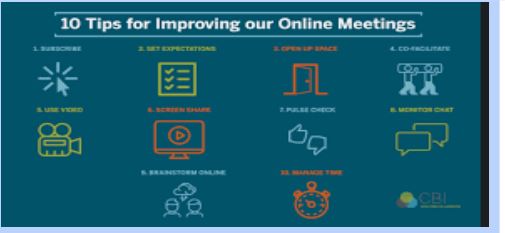Tips to Make your Online Meetings More Effective and Interactive
Everyone has experienced meetings where only a few people do most of the talking. Not only are they a waste of your team’s time and energy, but they are also a complete bore. But getting everyone on the team involved can be challenging, especially if we are all in different physical locations. The human tendency to zone out, multitask, or lose focus during virtual meetings is much stronger than in face-to-face meetings.
This post will discuss strategies, tools, and etiquette to help you engage remote attendees.
1. The meeting agenda is the first step in getting people involved in the discussion.
If you want people to participate in your meeting, you should start with the agenda. With a predetermined schedule, meetings are more organized and easier to manage. Use the plan to make the session more engaging with some planning. Moreover, organize meeting notes to ensure you don’t remain blank while discussing an agenda.
- Pre-share it with your colleagues: Some people don’t like thinking on their feet. Distributing the meeting’s agenda in advance will give everyone an equal opportunity to prepare for it and will ensure that no topics are off-limits. Giving people at least 24 hours notice before sharing is best.
- Explanation of why you’re writing these People are less likely to participate in a discussion if they have no emotional investment in the topic. This can be avoided by clearly stating the reason for the meeting and assigning specific responsibilities to each participant. Every participant in the conference will better understand their role and the importance of their input if this is done.
- Encouraging teamwork by Making the agenda a group effort is another way to get everyone invested in the meeting’s outcome. A meeting facilitator may solicit topics for discussion in advance or use a tool like Range to allow participants to submit issues in real-time.
2. Use a few “icebreaker” questions to get people talking.
You can use icebreaker questions to break the ice and get everyone talking to one another. They encourage people to share their thoughts and questions during meetings. A quick icebreaker in the first few minutes of your session can get everyone talking right away and establish trust among participants. They’re also fantastic for building a more robust team culture over time.
The best icebreakers cover a wide range of topics to get people talking. Ask each other questions ranging from lighthearted to deep to learn more about each other’s personalities and interests outside of work.
3. Ensure it is visual
Meetings that are held remotely are ideal for trying out new kinds of visual aids.
It takes a lot more mental effort to stay on track during a virtual meeting because our eyes rush from the presenter to the audience members as we try to gauge their reactions. Some studies have shown that looking at one’s reflection can be mentally taxing and lead to a more critical outlook on one’s appearance.
4. Gamification can take your meetings to the next level.
Using games and activities in meetings can help to increase energy levels and productivity. Using game mechanics in non-game contexts, such as business meetings, is known as “gamification.” Growing evidence suggests that workplace gamification can have a significant effect on efficiency. It’s a major factor in boosting efficiency and enthusiasm. It also ensures you engage staff in meetings; hence no one feels left out. Additionally, studies show that after a 45-minute teambuilding game, newly formed groups can improve their performance on tasks by as much as 20%.
5. Use live polls and surveys to get immediate user input.
Start a meeting by asking everyone about their week, what they’re most looking forward to talking about, and what they’re most proud of. Having some idea of the status of your teammates before a conversation will help you approach them more empathetically. (For instance, if someone is noticeably quieter than usual in a meeting, it can be instructive to interpret this as a sign that they are low on energy because they didn’t get enough sleep the night before rather than as a sign that they are entirely disengaged from the discussion.) Inquiring about the schedule can help you set priorities, while pre-meeting introspection can fortify relationships and boost confidence.
Polls and surveys administered amid a meeting are excellent for gauging attendees’ interests, stimulating conversation when interest flags, and ultimately altering the agenda. For example, you can use a simple yes/no question like, “Has this meeting been a valuable use of time so far?” to gauge the room’s temperature. Attendees who say “no” indicate a need to reevaluate the situation. Ask for feedback on how the meeting went and how it may be improved at the end. It can also be useful to make use of resources like this board minutes template uk, that can make the process of recording meetings easier. This can be beneficial for going back to assess how the meeting went and gauge various responses throughout that you might not have had time to think about at the time. Beyond this, it also helps with legal compliance when it comes to meetings involving directors, so that can be a big plus!
In conclusion, an online meeting can be tedious; hence hists need to develop ways to ensure that the sessions are interactive, productive, and resourceful.





